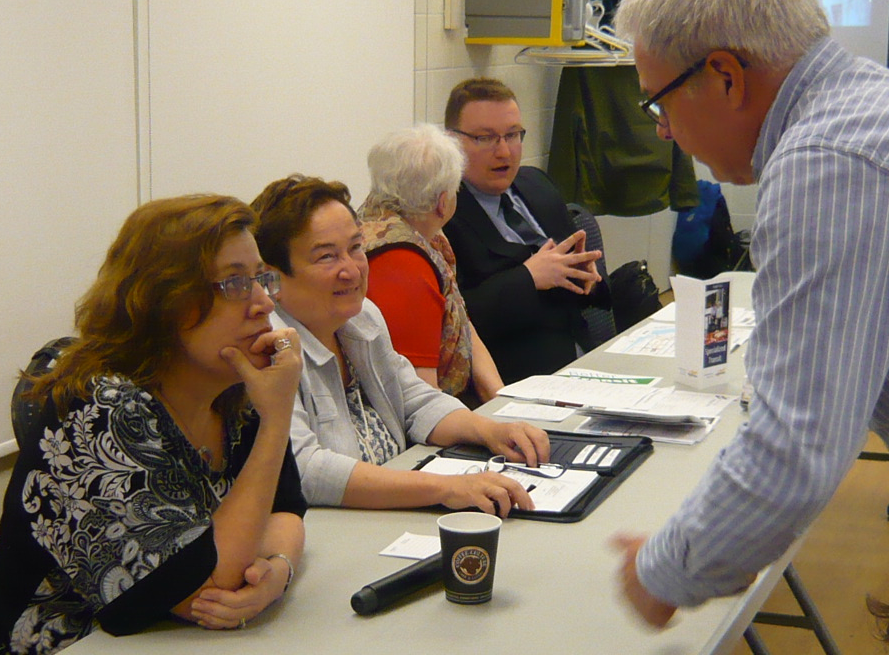 By Pepper Parr
By Pepper Parr
July 26th, 2019
BURLINGTON, ON
This is a seven part series on transit and how Burlington plans to get to the point where the public will take public transit to get to where they want to go in the city because it is cheaper, faster, more convenient and seen as the smart thing to do.
Part 3
Mobility Management acknowledges all the ways that people can travel in a community and all of the different ways that these modes can be operated; bringing them together for the benefit of the customer. While Burlington Transit primary focus over the next years will be the delivery of public transit services, it is important to start investing and rethinking how Burlington Transit thinks about mobility as a whole.
Strategy 2A: Implement On-demand Alternative Service Delivery Models
On-demand transit (or microtransit) is a traditional form of mobility that is experiencing a resurgence with the help of technology. On-demand transit has four components that differentiate it from conventional fixed-route transit:
• Flexible routing and/or scheduling designed based on customer demand;
• Newly-emerged “mobility brokers” who use mobile apps to connect supply and demand;
• Use of smaller, more flexible vehicles; and
• Connecting multiple transportation services to complete a trip (using a mobile app).
On-demand transit can be differentiated from conventional transit in the way that it caters to individual needs. In an On-demand Transit model, the transit service adapts to its customers, while in conventional transit service models, transit customers must adapt to the service offered. In many cases, this provides greater convenience and customization – moving towards some of the favourable characteristics of private automobile travel. On-demand transit offers a level of flexibility, convenience, and individualism somewhere between regular fixed-route transit (“public collective transport”) and private individual transport.
There are several advantages to exploring the implementation of On-demand transit services:
• Cost Effective: On-demand transit services are typically planned in areas where there is low ridership in a larger geographic area. This allows the transit agency to reduce the number of resources required to provide service.
• Improved Coverage: On-demand transit services offer a significant advantage in terms of coverage area. Since the vehicle is not tied to a fixed-route, this increases the number of residents within a five-minute walk of an on-demand transit pick-up or drop-off point.
• Early Introduction of Service: On-demand transit service allows for early introduction of transit service in newly developing areas without committing significant resources to provide mobility for new residents.

Director of Transit Sue Connor gets out into the community and listens: seen as effective by those who have worked with her and close to adored by her staff who are energized and motivated.
On-demand transit services do not entirely replace the need for fixed-route services. Fixed-route transit services require customers to make travel decisions based on pre-set transit routes and schedules. This model is effective when:
• Residents are in close proximity to a service;
• The route provides relatively direct service with minimal deviations that increase travel times;
• Higher frequencies are provided to increase the flexibility of the service; and
• There is a high demand for service between similar origins and destinations, which requires a high capacity vehicle to service.
This initiative works towards Burlington Transit’s Strategic Direction #2 (Be Forward-Thinking in how services are planned and delivered), particularly Objective 2.2 (Alternative Service Delivery), by exploring and seeking to implement on-demand alternative services.
Recommendations:
• Further explore the use of On-demand transit services as a replacement of certain fixed-route services. This should include a review of both dedicated and non-dedicated service models.
• Develop an On-demand transit service model and business case for low demand areas and operating periods, allowing customers to use a mobile app to book a shared-ride demand- responsive service to connect to the fixed-route service. This should coincide with the modifications to the existing route network to more of a grid-like structure (see Strategy 2A).
Strategic Direction 2B: Explore Partnerships with Other Mobility Providers
To address this expanding world of mobility, Burlington Transit needs to continue to evolve and see themselves as not only an operator of transit services, but as a partner and collaborator of sustainable mobility services. This means making it easier for customers to take all sustainable mobility options available to them or integrating services to allow customers to easily transfer between multiple modes.
Over the next five years, it is recommended that Burlington Transit continue to explore partnerships with TNCs, bike sharing companies, carpooling companies, taxi operators and other sustainable mobility providers to promote integration with Burlington Transit services. This could include:
1. Information Sharing and Promotion
2. Data Sharing
3. Trip Planning Integration
4. Service Integration
5. Fare Integration

What Sue Connor brought to Burlington was an understanding that transit is both a service and a business – one that goes far beyond running big vehicles up and down the streets of the city. She understands what the future of public transit is likely to be – and gives presentations to anyone who will listen.
This strategy aligns with Burlington Transit’s Strategic Direction #3 (Be Business-Minded and aligned with municipal directions), particularly Objective 3.2 (Partnerships), by seeking to partner with providers to improve efficiency, systems and lower cost.
Recommendations:
• Expand the role of a senior member of the Burlington Transit administration and management team to include the exploration of partnership approaches with other sustainable mobility service providers.
• Promote sustainable mobility services through awareness, marketing and education campaigns to inform residents of alternatives to driving alone in private vehicles.
Strategic Direction 2C: Integration of Specialized Transit and On-demand Transit Service
A key strategic direction will be to better integrate specialized transit trips with On-demand transit trips. If Burlington Transit uses its own fleet to deliver On-demand transit services, it is recommended that the Specialized Transit logo be removed from all its specialized transit vehicles, replaced with a Burlington Transit logo.
This will allow the same vehicle to be used to provide both specialized transit and On- demand Transit Services. The goal is to provide more flexibility in utilizing the right vehicle for the right type of trip, irrespective of whether a customer is registered for specialized transit service. This strategy helps support the integration of customers on vehicles that were traditionally reserved for specialized transit customers and will allow for more efficient scheduling and increase the available capacity to all Burlington Transit customers.
Under the integrated service model, a vehicle used to provide specialized transit service can also be used to provide On-demand transit service, and vice versa. This means that the services would be “co-mingled”, and specialized transit and On-demand transit service customers may share vehicles if it provides greater efficiency in the delivery of their trips. The decision to integrate trips will be based on the ability to utilize existing in-vehicle capacity and provide a better level of service to customers.
It should be noted that specialized transit will continue to operate as a core service for registered customers and any integration with On-demand transit service should not reduce the level of service for registered specialized transit customers.
Integration helps to achieve Burlington Transit’s Strategic Direction #3 (Be Business-Minded and aligned with municipal directions), particularly Objective 3.3 (Efficiency), as it allows for the delivery of similar on-demand services to combined, thereby reducing unnecessary administrative and operational duplication.
Recommendations:
• Explore the concept of integrating specialized transit services with On-demand transit services. A prerequisite of this approach is demand-response software in place to support the functions required by customers and staff.
Part 1: Transits five year plan has what some might call an over abundance-of wishful thinking
Part 2: Strategies and recommendations to create the needed structure and delivery model.



















Re: “… to get to the point where the public will take public transit….because it is cheaper, faster, more convenient and seen as the smart thing to do.” – It seems logical to start by demonstrating that those criteria are indeed valid advantages of public transit, with an economic evaluation comparing its cost with the cost of car ownership. Then address The 4 Ps of Marketing.